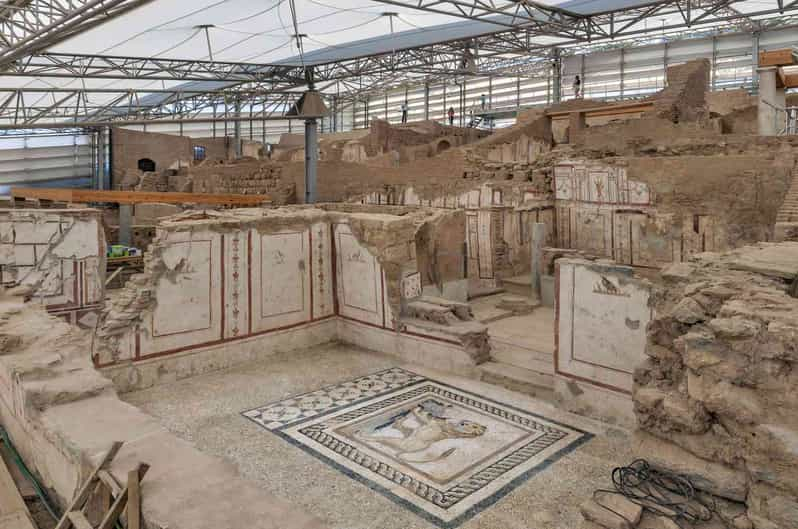The Ephesus Terrace Houses, nestled on the scenic slopes of Bulbul Mountain and located directly across from the iconic Hadrian Temple, provide a fascinating window into the luxurious and sophisticated lives of Roman elites. Often referred to as “the houses of the rich,” these remarkable structures not only showcase the wealth and architectural prowess of their inhabitants but also offer invaluable insights into the domestic life of the Roman aristocracy.
The Unique Location and Historical Significance
Built according to the Hippodamian grid plan, a city layout characterized by roads intersecting at right angles, the Ephesus Terrace Houses were strategically positioned on three terraces, at the lower end of the slope of Bulbul Mountain. The location directly across from Hadrian Temple underscores the significance of these homes, offering a stunning view of one of Ephesus’s most famous landmarks. Dating back to the 1st century BCE, these homes remained in use until the 7th century CE, providing a fascinating historical record of life in the city over several centuries.

Architectural Features: A Blend of Luxury and Innovation
One of the most striking aspects of the Ephesus Terrace Houses is their advanced architectural features, which reflect the wealth and cultural sophistication of their inhabitants. The homes boast intricate mosaics, vibrant frescoes, and advanced engineering systems such as underfloor heating.

Mosaics and Frescoes: Artistic Expression and Mythology
The mosaics found within the terrace houses are some of the finest examples of Roman artistry. These intricate floor designs, many of which feature scenes from Roman mythology, include the renowned “Dionysus Mosaic,” which depicts the Roman god of wine in all his vibrant glory. Frescoes on the walls provide a glimpse into the tastes and cultural influences of the elite residents, with intricate depictions of nature, animals, and deities that highlight their appreciation for beauty and symbolism.

Hypocaust Systems: The Pinnacle of Roman Engineering
The use of hypocaust systems—an advanced form of underfloor heating—was a luxury that set the homes of the elite apart from those of ordinary citizens. This engineering marvel allowed the residents to enjoy a warm and comfortable living environment even during the cooler months, underscoring the high level of sophistication and technological advancement in Ephesus.

Spaces for Leisure and Socializing
The Ephesus Terrace Houses were more than just private residences; they were spaces designed for social interaction, entertainment, and relaxation. Large courtyards, private baths, and spacious rooms were meticulously planned to accommodate gatherings of family and guests. Some of the homes feature private gardens, statues, and ornate columns, further enhancing the sense of luxury and comfort.
Reflection of Social Status and Cultural Refinement
These homes were not simply practical living spaces; they were a reflection of the high social status of their inhabitants. The design and furnishings of the terrace houses indicate that their owners were not only wealthy but also culturally refined, with a deep appreciation for art, architecture, and leisure.

A Glimpse into Urban Planning and Domestic Life
The careful planning and positioning of the terrace houses offer a unique perspective on the urban development of Ephesus. The houses were built with practicality and luxury in mind, blending public and private spaces to create a harmonious living environment. This urban layout provides important insights into how the elite of Ephesus lived, interacted with their surroundings, and navigated the demands of social status.

A Living Legacy: Ephesus Today
Today, the Ephesus Terrace Houses continue to captivate visitors from around the world. Ongoing excavations and restorations provide a rare opportunity to step back in time and explore the lavish lifestyles of one of the most powerful cities in the Roman Empire. As visitors walk through the well-preserved rooms and admire the intricate mosaics, they gain a deeper understanding of how the elite of Ephesus lived and how their society shaped the course of history.
These homes serve not only as a glimpse into ancient Roman life but also as a testament to the wealth, sophistication, and cultural importance of Ephesus, a city that was once a hub of trade, culture, and luxury in the ancient world.

